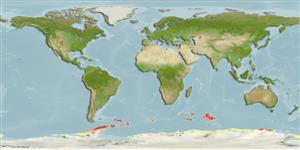| Native range |

|
| Lepidonotothen squamifrons AquaMaps Data sources: GBIF OBIS |
Length at first maturity
Lm ?, range 19 - 36 cm
Human uses
Fisheries: minor commercial
Phylogenetic diversity index
(Ref. 82805)
PD50 = 1.0000 many relatives (e.g. carps) 0.5 - 2.0 few relatives (e.g. lungfishes)
Trophic Level
(Ref. 69278)
3.5 ±0.52 se; Based on food items.
Resilience
(Ref. 69278)
Low, minimum population doubling time 4.5 - 14 years (K=0.08-0.12; tm=7-9; tmax=19; Fec = >10,000)